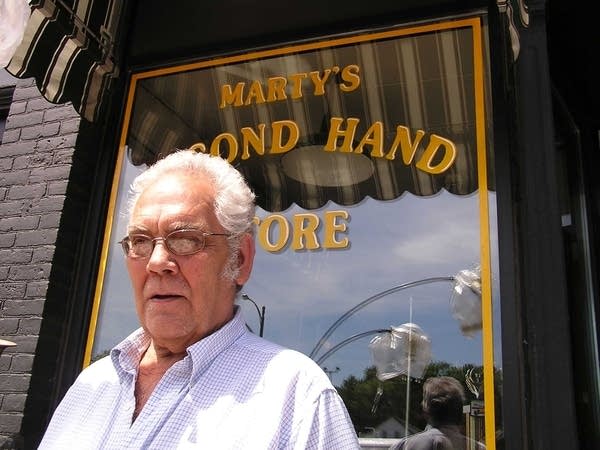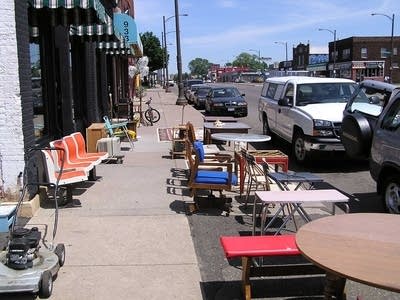Fate of Central Corridor linked to funding questions

The Central Corridor light rail project would use money from the state's motor vehicle sales tax, MVST. However there's no guarantee voters will approve the idea.
The November election ballot asks Minnesotan's if they approve spending all the MVST revenue on statewide transportation including transit projects. Right now about half of MVST is spent on transportation. Half goes to the general fund.
Metropolitan Council chairman Peter Bell says its back to the financial drawing board if voters don't approve the ballot question.
"If that constitutional amendment does not pass, that's going to raise some serious questions about our ability to go forward with the Central Corridor," he said.
Create a More Connected Minnesota
MPR News is your trusted resource for the news you need. With your support, MPR News brings accessible, courageous journalism and authentic conversation to everyone - free of paywalls and barriers. Your gift makes a difference.
About half of the money for the proposed $840 million Central Corridor light rail line would come from the federal government. The rest would come from the state and from Ramsey and Hennepin Counties.

The 17 members of the Metropolitan Council, all appointed by Gov. Tim Pawlenty, are expected to vote on recommending either a light rail or a bus rapid transit plan. Business and community support for light rail prompts predictions the Council will recommend tracks over tires.
The light rail line would run from downtown St. Paul, around the state capitol and onto University Avenue. It would roll west into Minneapolis branching off into a tunnel under Washington Avenue, cross the Mississippi River and end in downtown Minneapolis.
St. Paul resident Bob Johnson, who lives near University and relies on the bus, says he doesn't oppose light rail if there's still bus service.
"I think in a way it'll be a good idea," he says. "It depends on how they run it. They still want to keep the buses running I think, for the older people, people like ourselves, we don't want to go a mile to catch a stupid train."
The proposed light rail stations would be about a mile apart, and if the line is built Peter Bell says bus service will decline.
"Bus service will be reduced on University Avenue. It is a wide open question by how much it is going to be reduced," Bell said.
If (the) constitutional amendment does not pass, that's going to raise some serious questions about our ability to go forward with the Central Corridor.
Long before the first train runs there'll be several years of construction.
Gilbert Marty, who owns the building that houses his second-hand store on University in St. Paul, says he's worried the construction will close the street and kill his 20-year old business.
Projections are the light rail line would carry 34,000 people a day. But Marty relies on customers in vehicles pulling up and dropping off or picking up the second hand chairs, sofas and mattresses he sells. If he's still in business after construction Marty worries traffic restrictions will finish off what construction didn't kill.
"I think it's good for people count, the number of people that go by and see your place," he says. "However once light rail is here nobody will be able to park in front of my building."
Like the level of future bus service, parking restrictions haven't been decided should light rail be built. The proposed Central Corridor line is one of a handful of major projects that signal an uptick for Twin Cities transit.
The momentum got rolling with the success of the Hiawatha light rail line from downtown Minneapolis to the airport and the Mall of America.
Transit hopes also got a big boost this past legislative session. Advocates of the Northstar commuter rail line from the northwestern Twin Cities community of Big Lake to downtown Minneapolis cheered an apparent deal with Burlington Northern Santa Fe over a key track leasing agreement.
Also, lawmakers and Gov. Pawlenty earmarked planning money to advance bus rapid transit projects including the Bottineau bus line from Minneapolis northwest to Brooklyn Park, the Cedar Avenue commuter bus line from St. Paul to Apple Valley and the 35W commuter bus service from Minneapolis to southern suburbs.

Transit expansion can't come too soon for people interested in transportation options to the car.
Lea Schuster, the Executive Director of St. Paul-based Transit for Livable Communities, an advocacy group, says Minnesota's failure to find a dedicated source of funding for transit is one reason the Twin Cities is well behind other areas of the country.
"City after city...competitor cities, really make the local investment of funds usually through a sales tax increase that allows them to draw on the federal government's matching money that allows them to build systems that are $5 billion worth of new infrastructure," she says.
Taxpayers and elected officials blanch at those amounts. But University of Minnesota Humphrey Institute transportation analyst Lee Munnich says all transportation systems including roads are expensive. He says our car reliant system in the Twin Cities is out of balance. Munnich says a mix of options, including bus service, takes some of the pressure off roads.
"People have sort of written off the bus, and with rail they're starting to take another look and if they look at the rail system they say, 'Maybe I'll take the bus to get to the rail point,'" he says.
Advocates for roads and bridges have a firm political grip on Minnesota's transportation dollars. But business groups and suburban commuters are beginning to be heard. They want more and better roads, but their use of express buses and the Hiawatha line shows they use other options including rail when they're available.

Sierra Club transportation policy analyst Mathews Hollinshead of St. Paul, a long time rail advocate, says support for Northstar commuter rail from Big Lake to Minneapolis is a key development.
"I think it's a tipping point and once that's up and running you'll see people, you already see it now, people have pretty much realized that our future is with a real transit system. It's just a question of how we get there especially in terms of funding," he says.
On the funding question, voters and many elected officials appear intransigent. The state's gasoline tax hasn't been increased from 20 cents a gallon since 1988. The result is inflation has eaten away a third of the buying power of the gas tax revenue. Various transit funding ideas including a Twin Cities regional sales tax have been rejected.
The result is advocates of all stripes shy from predicting what Minnesota voters will do this fall when they're asked if they want to aim all motor vehicle sales tax revenue at statewide transportation projects including transit.

